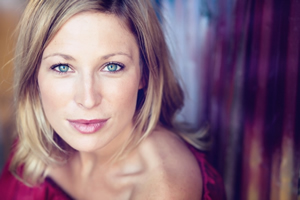Conductor Andrew Grams led the Brevard Music Center Orchestra in the superb capstone concert of the July 4th weekend in Whittington-Pfohl Auditorium, featuring Los Angeles pianist Norman Krieger in Johannes Brahms’ Piano Concerto No. 2 in B-flat, Op. 83, and Paul Hindemith’s programmatic symphony Mathis der Maler. Grams’ many accomplishments to date belie his young years. He has earned degrees from Juilliard and the Curtis Institute of Music, completed a three-year term with The Cleveland Orchestra as Assistant Conductor, and has led several other major orchestras. His conducting is measured and meticulous, and while not excessively emotional, shows an impressive musical intelligence.
Krieger holds Bachelor’s and Master’s degrees from Juilliard, and studied further with Alfred Brendel and Maria Curcio in London. He also holds an Artists Diploma from the New England Conservatory, where he worked with Russell Sherman. He has an international concert career, and has recorded a wide variety of works with several labels. Krieger is the founding Artistic Director of the Prince Albert Music Festival in Hawaii. Since 1997, he has served as Associate Professor of Keyboard Studies at the Thornton School of Music, University of Southern California.
The program’s two German compositions — programmatic vs. abstract — embodied the polar opposites of the ideological spectrum so hotly debated in musical circles of their time. Hindemith’s Mathis der Maler, his first symphony composed from 1933-34, was drawn from his fanciful opera concerning the real-life sixteenth-century German painter Matthias Grünewald. In the opera, Grünewald abandons his artistic world to join a political struggle, only to return to his work with a renewed sense of purpose.
Each movement of Hindemith’s symphony represents one of Grünewald paintings from the Isenheim Altarpiece, painted ca. 1510-1515 for the monastic hospital order of St. Anthony. The first movement (in sonata form), “Engelkonzert” (“The Angelic Concert”), depicts angels playing instruments (some in a contorted fashion) and singing hymns in honor of Christ’s birth. References to church style include chorales played on trombones (sackbuts in former times) and counterpoint. The strings eventually take up the second, expansive major melody, like Grünewald’s “angels.” The orchestra’s tempo overall was a little too deliberate, I thought. The climaxes, however, were thrilling, and oboe, flute, and clarinet solos beautifully played. The second meditative slow movement (in ternary form), “Grablegung” (“Entombment”), is of Christ laid in the tomb, mourned by three figures. This is a movement of lone voices — solo flute, then oboe, then a duet at the onset. Short questioning phrases begin and end over and over, as if to ask, “Why?”
The third movement (also composed in a kind of ternary form), “Versuchung des heiligen Antonius” (“The Temptation of St. Anthony”), correlates with the painter’s hellish landscape of tormentors encircling the saint. The movement begins with a melody with menacing trills in the strings, trills that return again and again like buzzing bees, ending in a thunderclap of orchestral chords. The solo voices of oboe, flute, and clarinet were heard against an obbligato tide of strings. Tricky syncopations in the brass and quick double-tongue articulation in the winds were deftly tossed off as a piece of cake. Hindemith’s musings on the meaning of art and the connections of the artist to his creations and the larger world had profound resonance with the events of his own life; his work was eventually denounced by the Nazis and he fled to the U.S.
Brahms, a life-long opponent of program music, wrote his second piano concerto between 1878 and 1881, and was the soloist at its premiere in Budapest. This is a quirky piano concerto, to be sure, and much has been made of the work’s anomalies, especially its expansion into four movements with the addition of the second movement “Scherzo.” As Bruce Murray wrote in the program notes: “…we have a first movement that’s really a symphony, a scherzo that shouldn’t be here at all, and a slow movement that is really chamber music. By now we don’t know what to expect for the finale, yet Brahms manages to confound us still with something light, playful, domestic…a ‘quodlibet:’ a taste of the beer hall, a little Hungarian, some scales on the piano, pretty much his daily routine.”
The concerto is more like a double concerto for two orchestras (one of them masquerading as a piano) — the writing for piano is so dense and development of ideas so relentless. There are no vacuous displays or fluff for the piano — Brahms had no taste for such shenanigans. Also, it’s often that the piano plays the expository material first, then echoed by the orchestra, another role reversal. Norman Krieger’s performance was simply riveting. He’s a player with an enormous range of expressiveness, energy, lightning reflexes, and seemingly innate musicality. The first movement “Allegro non troppo,” declamatory and lengthy, demanded enormous strength and concentration, which he delivered. There was no letup in the “Scherzo,” for in Brahms’ hands this was no feathery, lightweight movement, but another cascade of developing ideas — relentlessly serious and endlessly interesting. The third movement “Andante” was the showstopper, for here the solo voices emerged, beginning with the famous cello solo, creating an air of intimacy so startlingly different from the previous two movements. The performers created a virtual time warp, with time suspended in vast sonic space. The finale “Allegretto grazioso” is one of Brahms’ funniest works, a romp with rhapsodic “Hungarian” themes with playful halts, the sound of the cimbalon, and those scales to which Murray referred. Here the ensemble was so tight it was like hearing an old married couple completing one another’s sentences. Kudos to soloist, conductor, and orchestra for a most memorable concert!











